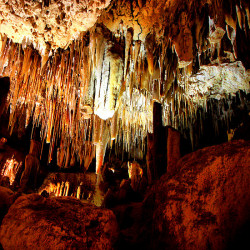Kelly Hill Caves
Useful Information
| Location: | On Kangaroo Island. South Coast Road in the Kelly Hill Conservation Park. |
| Open: |
Summer, autumn, spring holiday daily 10, 10:30, 10:45, 11:15, 12, 12:15, 13:15, 14:15, 15:15, 16:15. All other times daily 10:30, 11:15, 12:15, 13:15, 14:15, 15:15, 16:15. [2005] |
| Fee: |
Adults AUD 11, Children (3-14) AUD 6.5, Concession AUD 8.75, Family AUD 29. Cave Trekking: Original Cave Entrance tour: Adults AUD 27.50, Children (3-14) AUD 16.50, Concession AUD 22, Family AUD 75. K9 tour: Adults AUD 27.50, Children (3-14) AUD 16.50, Concession AUD 22, Family AUD 75 Torch and helmet hire AUD 2.00. [2005] |
| Classification: |
 Karst Cave
aeolian calcarenite of Pleistocene age. Karst Cave
aeolian calcarenite of Pleistocene age.
|
| Light: |
 Incandescent Incandescent
|
| Dimension: | |
| Guided tours: | D=40 min. |
| Photography: | |
| Accessibility: | |
| Bibliography: |
Harold Bell (1926):
Glorious Kangaroo Island - Its Caves and Beauty Spots,
Reprinted 2000.
|
| Address: |
Kelly Hill Caves, Kangaroo Island Parks, R.M.B. 38, via Kingscote. SA. 5223, Tel: +61-8-8559-7231.
Michael Wigg, Ranger-in-Charge.
E-mail: |
| As far as we know this information was accurate when it was published (see years in brackets), but may have changed since then. Please check rates and details directly with the companies in question if you need more recent info. |
|
History
| 1880 | caves "discovered" by a local stockman called Kelsy and his horse Kelly. |
| 18-NOV-1925 | discovered and first explored by the local Harold Bell. |
| 1926 | first guided tours by Harold Bell, who was appointed caretaker of the caves. |
| 1972 | caves passed under the management of the National Parks and Wildlife Service. |
| 25-NOV-2000 | 75th anniversary of the discovery of Kelly Hill Caves. |
Description

©2008 Globalphotos/Varinia, used under our Fair Use policy.
The name of Kelly Hill Caves is a result of the story, how it was discovered.
In 1880 a local stockman called Kelsy, riding on hishorse Kelly, was chasing sheep that had strayed from his property.
Unfortunately both of them fell into one of the big
 Doline
in the area.
Kelsy managed to climb out, but he had to leave Kelly at the bottom of the sink hole.
He returned soon with help to rescue the horse, but it was gone.
Now oral tradition knows at least three versions of the end of this story, which makes the whole story a bit weird.
The realistic version has it, the farmer may have gone back to the wrong hole.
The optimitic version tells, the horse was later pulled to safety.
And the mysterious end talks about Kelly the horse wandering off into the labyrinth of caves never to be seen again.
And so its skeleton may still be somewhere in the caves waiting to be discovered.
Doline
in the area.
Kelsy managed to climb out, but he had to leave Kelly at the bottom of the sink hole.
He returned soon with help to rescue the horse, but it was gone.
Now oral tradition knows at least three versions of the end of this story, which makes the whole story a bit weird.
The realistic version has it, the farmer may have gone back to the wrong hole.
The optimitic version tells, the horse was later pulled to safety.
And the mysterious end talks about Kelly the horse wandering off into the labyrinth of caves never to be seen again.
And so its skeleton may still be somewhere in the caves waiting to be discovered.
All in all this story is definitely a good reason to name the caves after Kelly the horse. But the caves were still not discovered, just the existence of caves and dolines in this area was mentioned by the people.
The tourist history of the cave started with the local Harold Bell who explored the caves of the area and soon made the first guided tours with candlelight. He was appointed caretaker of the caves one year after the discovery and wrote a book about the cave the same year. At his time the chambers of the cave were numered to allow visitors to find their way back. The remains can still be seen at the ceiling.
The cave contains numerous speleothems,
 straws,
straws,
 stalactites and
stalactites and
 stalagmites, but most impressive are the various
stalagmites, but most impressive are the various
 helictites
helictites
 Search DuckDuckGo for "Kelly Hill Caves"
Search DuckDuckGo for "Kelly Hill Caves" Kelly Hill Caves - Wikipedia (
Kelly Hill Caves - Wikipedia ( )
) Kelly Hill Conservation Park
Kelly Hill Conservation Park Index
Index Topics
Topics Hierarchical
Hierarchical Countries
Countries Maps
Maps